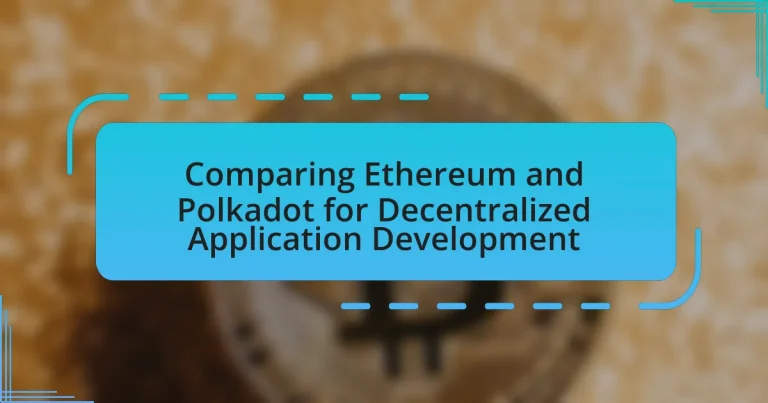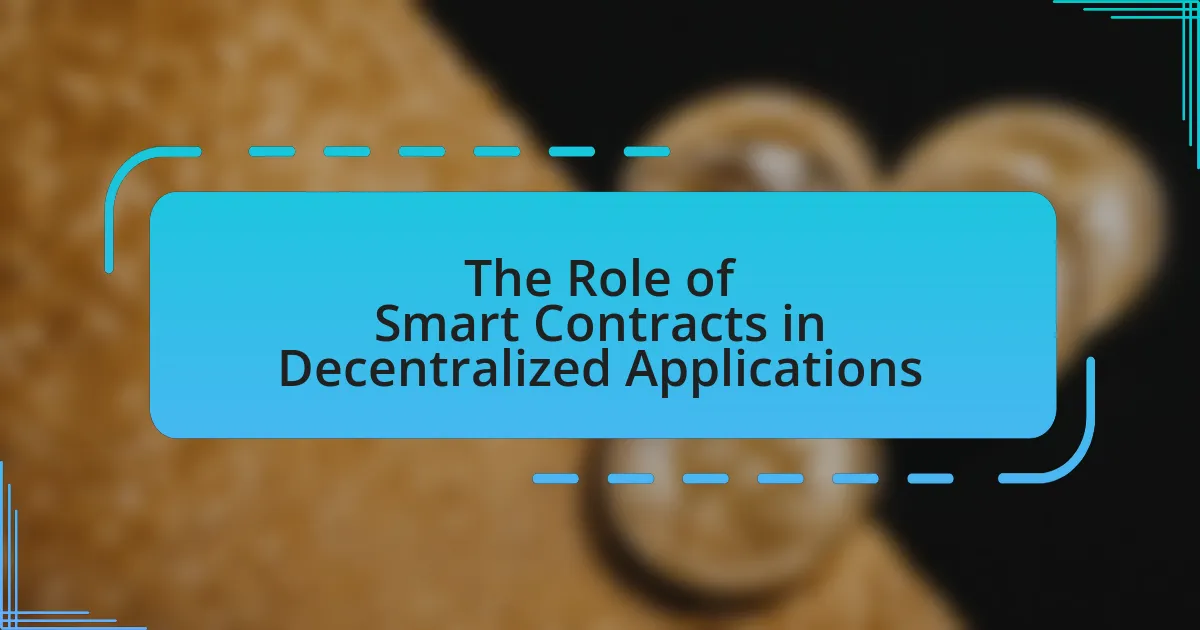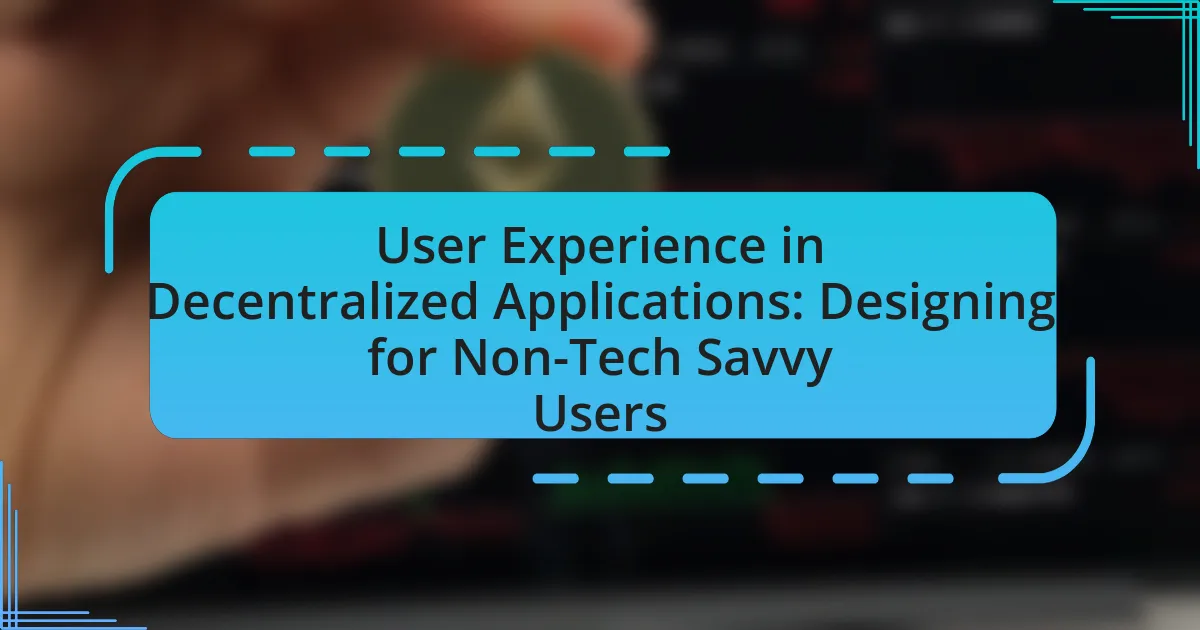The article compares Ethereum and Polkadot as platforms for decentralized application development, highlighting their key differences in architecture, scalability, consensus mechanisms, and developer resources. Ethereum operates on a single blockchain, which can lead to scalability issues and higher transaction fees, while Polkadot employs a multi-chain architecture that enhances scalability and interoperability. The article discusses how each platform approaches scalability, the programming languages supported, and the advantages and disadvantages of using either for development. Additionally, it addresses the challenges developers face on both platforms and provides guidance on selecting the appropriate platform based on project needs.
What are the key differences between Ethereum and Polkadot for decentralized application development?
Ethereum and Polkadot differ significantly in their approach to decentralized application development. Ethereum operates on a single blockchain, which can lead to scalability issues as the network grows, while Polkadot utilizes a multi-chain architecture that allows various blockchains to interoperate, enhancing scalability and flexibility.
Ethereum’s smart contracts are executed on its main chain, which can become congested, resulting in higher transaction fees and slower processing times during peak usage. In contrast, Polkadot’s parachains can process transactions in parallel, reducing bottlenecks and enabling lower fees.
Furthermore, Ethereum employs a proof-of-work consensus mechanism (transitioning to proof-of-stake), which can be energy-intensive, whereas Polkadot uses a nominated proof-of-stake system that is designed to be more efficient and secure.
These structural differences impact the development experience; Ethereum has a more established ecosystem with extensive developer resources, while Polkadot offers greater customization and interoperability for developers looking to create specialized applications across multiple chains.
How do Ethereum and Polkadot approach scalability?
Ethereum approaches scalability primarily through the implementation of Layer 2 solutions and the transition to a proof-of-stake consensus mechanism with Ethereum 2.0, which aims to increase transaction throughput and reduce congestion. Layer 2 solutions, such as Optimistic Rollups and zk-Rollups, allow transactions to be processed off-chain while still leveraging the security of the Ethereum mainnet, significantly enhancing scalability.
Polkadot, on the other hand, utilizes a unique multi-chain architecture that allows multiple blockchains (parachains) to operate in parallel, sharing security and communication through its Relay Chain. This design enables Polkadot to achieve high scalability by allowing different chains to handle their transactions independently while still being part of a larger ecosystem.
Both Ethereum and Polkadot aim to address scalability challenges, but they do so through fundamentally different architectural approaches: Ethereum focuses on enhancing its existing chain with Layer 2 solutions, while Polkadot builds a network of interconnected chains to distribute the load.
What mechanisms do Ethereum and Polkadot use to achieve scalability?
Ethereum achieves scalability primarily through the implementation of Layer 2 solutions, such as rollups, which bundle multiple transactions into a single one to reduce congestion on the main chain. Additionally, Ethereum is transitioning to a proof-of-stake consensus mechanism with Ethereum 2.0, which is designed to improve transaction throughput and reduce energy consumption.
Polkadot utilizes a unique architecture that includes a relay chain and multiple parachains, allowing for parallel processing of transactions across different chains. This design enables Polkadot to scale efficiently by distributing the load among various parachains while maintaining interoperability between them.
How does scalability impact decentralized application performance on each platform?
Scalability significantly impacts decentralized application performance on Ethereum and Polkadot by determining transaction throughput and latency. On Ethereum, scalability challenges arise due to its single-chain architecture, which can lead to congestion and higher transaction fees during peak usage, as evidenced by the network’s struggles during events like the DeFi boom in 2020, where gas fees surged to over $100. In contrast, Polkadot employs a multi-chain architecture that allows parallel processing of transactions across different parachains, enhancing throughput and reducing latency, which is supported by its ability to handle thousands of transactions per second without congestion. Thus, while Ethereum’s scalability limitations can hinder performance during high demand, Polkadot’s design facilitates better performance for decentralized applications by efficiently managing increased transaction loads.
What are the consensus mechanisms used by Ethereum and Polkadot?
Ethereum uses a consensus mechanism called Proof of Stake (PoS), while Polkadot employs a mechanism known as Nominated Proof of Stake (NPoS). Ethereum transitioned to PoS with the Ethereum 2.0 upgrade, which enhances energy efficiency and scalability by allowing validators to create new blocks based on the amount of cryptocurrency they hold and are willing to “stake” as collateral. Polkadot’s NPoS allows DOT token holders to nominate validators, ensuring a diverse set of validators and enhancing network security. Both mechanisms aim to improve decentralization and security while addressing scalability challenges in blockchain networks.
How does Ethereum’s proof-of-stake model work?
Ethereum’s proof-of-stake model works by allowing validators to create new blocks and confirm transactions based on the amount of cryptocurrency they hold and are willing to “stake” as collateral. In this model, validators are chosen to propose and validate blocks in proportion to their stake, which incentivizes them to act honestly, as they risk losing their staked assets if they behave maliciously. This system replaces the energy-intensive proof-of-work model, enhancing scalability and reducing environmental impact, as seen in Ethereum’s transition to proof-of-stake with the Ethereum 2.0 upgrade.
What is Polkadot’s Nominated Proof-of-Stake (NPoS) and how does it function?
Polkadot’s Nominated Proof-of-Stake (NPoS) is a consensus mechanism that enhances network security and scalability by allowing token holders to nominate validators who secure the network. In this system, nominators stake their DOT tokens to support chosen validators, and in return, they share in the rewards earned by those validators. This process incentivizes both validators and nominators to act in the network’s best interest, as misbehavior can lead to penalties, including loss of staked tokens. NPoS effectively balances the need for decentralization with the requirement for efficient block production, ensuring that the network remains robust and secure while facilitating the development of decentralized applications.
What programming languages are supported by Ethereum and Polkadot?
Ethereum primarily supports Solidity and Vyper for smart contract development. Solidity is a contract-oriented programming language specifically designed for Ethereum, while Vyper is a newer language that emphasizes security and simplicity. Polkadot, on the other hand, supports Rust and Ink! for developing smart contracts, with Rust being a general-purpose programming language known for its performance and safety features. Ink! is a Rust-based library tailored for writing smart contracts on the Polkadot network.
How does Solidity facilitate development on Ethereum?
Solidity facilitates development on Ethereum by providing a high-level programming language specifically designed for writing smart contracts. This language allows developers to create decentralized applications (dApps) that run on the Ethereum Virtual Machine (EVM), ensuring compatibility and ease of deployment across the Ethereum network. Solidity’s syntax is similar to JavaScript, which lowers the barrier to entry for developers familiar with web development, thus accelerating the development process. Additionally, Solidity supports features such as inheritance, libraries, and complex user-defined types, which enhance code reusability and modularity. The widespread adoption of Solidity has led to a robust ecosystem of tools, libraries, and frameworks, further streamlining the development workflow for Ethereum-based applications.
What languages can be used for building on Polkadot?
Polkadot primarily supports the Rust and Ink! programming languages for building decentralized applications. Rust is utilized for developing parachains and smart contracts, while Ink! is a Rust-based library specifically designed for writing smart contracts on the Polkadot network. This support is reinforced by the Substrate framework, which is built in Rust and allows developers to create custom blockchains that can seamlessly integrate with the Polkadot ecosystem.
What are the advantages and disadvantages of using Ethereum for decentralized application development?
Ethereum offers several advantages for decentralized application development, including a robust ecosystem, extensive developer resources, and established security protocols. Its large community and comprehensive documentation facilitate easier onboarding for developers, while the Ethereum Virtual Machine (EVM) allows for compatibility with various programming languages, enhancing flexibility in development.
However, Ethereum also has notable disadvantages, primarily its scalability issues and high transaction fees. The network can become congested, leading to slower transaction times and increased costs, particularly during peak usage periods. These limitations can hinder the performance of decentralized applications, especially those requiring high throughput.
What are the primary benefits of developing on Ethereum?
The primary benefits of developing on Ethereum include its robust smart contract functionality, a large developer community, and extensive ecosystem support. Ethereum’s smart contracts enable developers to create decentralized applications (dApps) that operate autonomously without intermediaries, enhancing efficiency and reducing costs. The platform boasts one of the largest developer communities in the blockchain space, which fosters innovation and provides extensive resources for troubleshooting and collaboration. Additionally, Ethereum’s ecosystem includes a wide range of tools, libraries, and frameworks, such as Truffle and Hardhat, which streamline the development process and enhance productivity. These factors collectively make Ethereum a leading choice for decentralized application development.
How does Ethereum’s large developer community enhance application development?
Ethereum’s large developer community significantly enhances application development by providing extensive resources, support, and innovation. This community contributes to a wealth of open-source tools, libraries, and frameworks, which streamline the development process and reduce time-to-market for new applications. For instance, the Ethereum GitHub repository hosts thousands of projects and code snippets that developers can leverage, fostering collaboration and knowledge sharing. Additionally, the community’s active participation in forums and events, such as Devcon, facilitates networking and mentorship opportunities, further accelerating skill development and project success. The sheer size of the community also leads to rapid identification and resolution of issues, ensuring that applications are more secure and reliable.
What resources and tools are available for Ethereum developers?
Ethereum developers have access to a variety of resources and tools that facilitate the development of decentralized applications. Key tools include the Ethereum development framework Truffle, which streamlines the process of building and testing smart contracts, and Hardhat, a flexible environment for Ethereum software development that allows for local blockchain simulation. Additionally, Remix IDE provides a web-based interface for writing, testing, and deploying smart contracts, while Infura offers scalable API access to the Ethereum network, enabling developers to connect their applications without running a full node. Furthermore, libraries like Web3.js and Ethers.js simplify interactions with the Ethereum blockchain, enhancing the development experience. These tools and resources are widely recognized within the Ethereum community, supporting efficient and effective decentralized application development.
What challenges do developers face when using Ethereum?
Developers face several challenges when using Ethereum, primarily related to scalability, high transaction fees, and complex development processes. Scalability issues arise because Ethereum’s current infrastructure can handle only a limited number of transactions per second, leading to network congestion during peak usage times. High transaction fees, often referred to as “gas fees,” can become prohibitively expensive, especially during periods of high demand, making it less economical for developers to deploy applications. Additionally, the complexity of Ethereum’s smart contract programming, particularly with Solidity, can pose a steep learning curve for new developers, increasing the likelihood of bugs and vulnerabilities in the code. These challenges are well-documented in various studies and reports on Ethereum’s performance and developer experiences.
How do high gas fees affect decentralized application development on Ethereum?
High gas fees significantly hinder decentralized application development on Ethereum by increasing the cost of transactions and smart contract interactions. Developers face challenges in budgeting for these expenses, which can deter innovation and limit the scalability of applications. For instance, during periods of network congestion, gas fees can spike to over $100 per transaction, making it economically unfeasible for developers to deploy and maintain applications. This financial barrier can lead to reduced user engagement and limit the overall growth of the Ethereum ecosystem compared to alternatives like Polkadot, which offers lower transaction costs.
What are the limitations of Ethereum’s current infrastructure?
Ethereum’s current infrastructure has several limitations, including scalability issues, high transaction fees, and energy consumption. Scalability is a significant concern as Ethereum can process only about 30 transactions per second, leading to congestion during peak usage times. This congestion results in high gas fees, which can exceed $50 during busy periods, making it costly for users to execute transactions or deploy smart contracts. Additionally, Ethereum’s proof-of-work consensus mechanism has been criticized for its high energy consumption, with estimates suggesting it consumes as much energy as some small countries. These limitations hinder Ethereum’s ability to support a large number of decentralized applications efficiently.
What are the advantages and disadvantages of using Polkadot for decentralized application development?
Polkadot offers several advantages and disadvantages for decentralized application development. The primary advantage is its interoperability, allowing different blockchains to communicate and share information seamlessly, which enhances scalability and flexibility in application design. Additionally, Polkadot’s unique architecture, featuring parachains, enables developers to create specialized blockchains tailored to specific use cases, improving performance and efficiency.
On the downside, the complexity of Polkadot’s ecosystem can pose challenges for developers unfamiliar with its architecture. The requirement for a certain level of technical expertise to build on Polkadot may limit accessibility for some developers. Furthermore, the relatively nascent stage of Polkadot compared to Ethereum means that it may have fewer established tools and resources, potentially hindering rapid development.
What unique features does Polkadot offer to developers?
Polkadot offers developers unique features such as interoperability, scalability, and a shared security model. Interoperability allows different blockchains to communicate and share information seamlessly, enabling developers to create applications that leverage multiple chains. Scalability is achieved through its parachain architecture, which allows multiple transactions to be processed in parallel, significantly increasing throughput. The shared security model ensures that all connected chains benefit from the security of the Polkadot network, reducing the need for individual chains to establish their own security measures. These features collectively enhance the development experience and capabilities for decentralized applications.
How does Polkadot’s interoperability benefit decentralized applications?
Polkadot’s interoperability significantly benefits decentralized applications by enabling seamless communication and data exchange across multiple blockchains. This capability allows decentralized applications to leverage the unique features and functionalities of various blockchains, enhancing their overall performance and user experience. For instance, a decentralized application built on Polkadot can access the security of the Bitcoin network while utilizing the smart contract capabilities of Ethereum, thereby creating more versatile and robust applications. This interconnectedness fosters innovation and collaboration among developers, as they can build applications that tap into diverse ecosystems, ultimately leading to a richer and more dynamic decentralized application landscape.
What role do parachains play in Polkadot’s ecosystem?
Parachains are integral to Polkadot’s ecosystem as they enable multiple blockchains to operate in parallel, enhancing scalability and interoperability. Each parachain can be customized for specific use cases, allowing developers to create decentralized applications tailored to their needs while benefiting from the shared security and communication provided by the Polkadot Relay Chain. This architecture allows for efficient transaction processing and data sharing across different parachains, which is crucial for the development of complex decentralized applications.
What challenges do developers encounter when using Polkadot?
Developers encounter several challenges when using Polkadot, primarily related to its complexity and learning curve. The architecture of Polkadot, which includes concepts like parachains and the Relay Chain, requires developers to have a deep understanding of its unique framework, making it more difficult for those familiar with traditional blockchain systems. Additionally, the interoperability features, while powerful, introduce complications in ensuring seamless communication between different blockchains. Furthermore, the development tools and documentation are still evolving, which can hinder the onboarding process for new developers. These factors collectively contribute to a steeper learning curve and potential delays in project development compared to more established platforms like Ethereum.
How does the complexity of Polkadot’s architecture impact development?
The complexity of Polkadot’s architecture significantly impacts development by introducing a multi-chain framework that requires developers to understand various components such as parachains, the relay chain, and cross-chain messaging. This complexity can lead to a steeper learning curve for developers compared to simpler architectures like Ethereum, which primarily operates on a single chain. Additionally, the need for interoperability among different parachains necessitates careful design and implementation, potentially increasing development time and resource allocation. The unique features of Polkadot, such as shared security and scalability through its architecture, can enhance application performance but also demand a more sophisticated approach to development, as developers must navigate the intricacies of the ecosystem to fully leverage its capabilities.
What are the potential risks associated with parachain auctions?
The potential risks associated with parachain auctions include financial loss, project failure, and market volatility. Participants in parachain auctions must lock up significant amounts of cryptocurrency as collateral, which exposes them to the risk of losing their investment if the project does not succeed or if the value of the collateral decreases. Additionally, the competitive nature of auctions can lead to inflated bidding, resulting in overpaying for a parachain slot. Historical data from previous auctions on Polkadot shows instances where projects failed to deliver on their promises, leading to substantial losses for investors. Furthermore, the overall market for cryptocurrencies is highly volatile, which can affect the stability and success of parachain projects.
How can developers choose between Ethereum and Polkadot for their projects?
Developers can choose between Ethereum and Polkadot for their projects by evaluating their specific needs regarding scalability, interoperability, and development environment. Ethereum offers a robust ecosystem with extensive documentation and a large developer community, making it suitable for projects that prioritize established infrastructure and smart contract capabilities. In contrast, Polkadot provides a unique architecture that allows for interoperability between different blockchains, which is advantageous for projects requiring cross-chain functionality. Additionally, Polkadot’s parachain model enables greater scalability and customization, appealing to developers looking for flexibility in their application design. Therefore, the choice hinges on whether the project requires Ethereum’s established network or Polkadot’s innovative interoperability features.
What factors should developers consider when selecting a platform?
Developers should consider scalability, security, community support, and development tools when selecting a platform. Scalability determines how well the platform can handle increased loads; for instance, Ethereum has faced congestion issues, while Polkadot offers a multi-chain architecture that enhances scalability. Security is crucial, as vulnerabilities can lead to significant losses; Ethereum has a longer track record but has experienced high-profile hacks, whereas Polkadot employs a unique shared security model. Community support influences the availability of resources and collaboration opportunities; Ethereum has a larger developer community, which can be beneficial for troubleshooting and innovation. Lastly, the availability of development tools affects the ease of building applications; both platforms offer robust tools, but the choice may depend on specific project requirements.
How can developers assess the long-term viability of their chosen platform?
Developers can assess the long-term viability of their chosen platform by analyzing factors such as community support, technological advancements, and market trends. Community support is crucial; platforms with active developer communities, like Ethereum, often receive continuous updates and improvements, which enhances their longevity. Technological advancements, including scalability solutions and interoperability features, indicate a platform’s ability to adapt to future demands; for instance, Ethereum’s transition to Ethereum 2.0 aims to improve scalability and energy efficiency. Market trends, including adoption rates and partnerships, provide insights into a platform’s relevance; Polkadot’s unique multi-chain architecture has garnered significant interest, suggesting strong future potential.
What best practices should developers follow when building decentralized applications on Ethereum or Polkadot?
Developers should follow best practices such as ensuring security, optimizing gas efficiency, and adhering to modular design principles when building decentralized applications on Ethereum or Polkadot. Security is paramount; developers must conduct thorough audits of smart contracts to prevent vulnerabilities, as evidenced by the numerous hacks in the DeFi space, which have resulted in losses exceeding $1 billion in 2021 alone. Optimizing gas efficiency is crucial for cost-effective transactions, particularly on Ethereum, where high gas fees can deter users; developers can achieve this by minimizing computational complexity and using efficient data structures. Lastly, adopting modular design principles allows for easier upgrades and maintenance, which is essential given the rapidly evolving nature of blockchain technology. By following these practices, developers can enhance the reliability and user experience of their decentralized applications.





